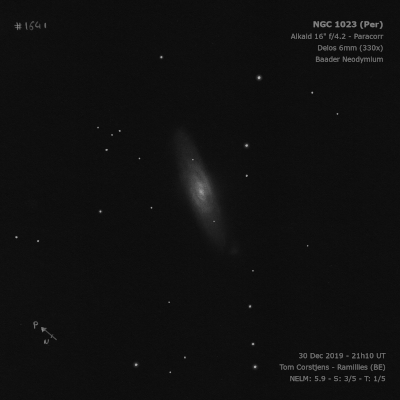
William Herschel discovered NGC 1023 = H I-156 = h242 on 18 Oct 1786 (sweep 618) and noted "eB, mE, a very BN, the branches losing themselves in the direction of the parallel nearly." On 17 Jan 1787 (sweep 692), he recorded "vB, gmbM to a very bright nucleus, mE nearly 10' long, from about 12? sp to nf." John Herschel sketched the galaxy in Oct 1828 and as well as Bindon Stoney on 27 Dec 1850 (included in plate XXV in Lord Rosse's 1861 publication).
200/250mm - 8" (11/8/80): fairly bright, bulging bright core, lens-shaped.
300/350mm - 13.1" (12/22/84): very bright, impressive, elongated ~E-W, bright core, stellar nucleus.
400/500mm - 17.5" (12/8/90): bright, large, very elongated 7:2 E-W, very bright core, almost stellar nucleus. A large fainter halo increases the dimensions to 7'x2'. Two 15th magnitude stars are superimposed on the east and west ends.
900/1200mm - 48" (10/25/11): this gorgeous galaxy appeared extremely bright, very elongated 4:1 E-W, ~7'x1.8', with a large, brighter central core that increases to an intensely bright inner core punctuated by a bright stellar nucleus. The outer halo gradually fades at the ends of the extensions. Several stars are superimposed on both sides of the core.
NGC 1023A = PGC 10139, a low surface brightness dwarf companion, is superimposed on the east side (2.4' ESE of center). It appeared as a faint, fairly large, low surface brightness patch oriented SSW-NNE, roughly 1.2'x0.8', and it blends into the main galaxy. Although most of the companion is within the halo of NGC 1023, part of it juts out the southeast edge of the galaxy. The halo of NGC 1023 extends beyond (east) of the dwarf.
Notes by Steve Gottlieb